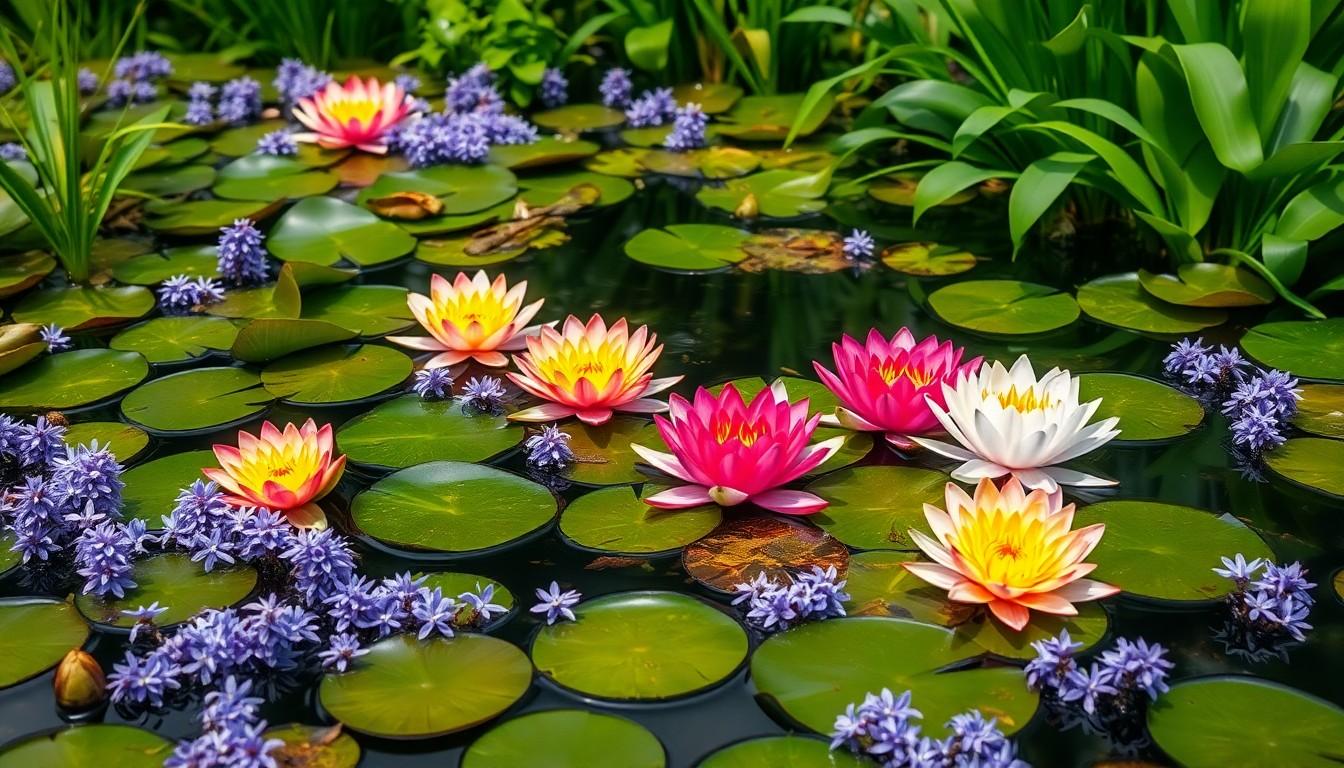Imagine a garden where flowers dance on water instead of soil. Aquatic flowers bring a splash of color and whimsy to ponds, lakes, and even your backyard water feature. These fascinating blooms not only beautify their watery homes but also play a vital role in maintaining the ecosystem. Who knew that something so lovely could also be so hardworking?
Overview of Aquatic Flowers
Aquatic flowers are unique plants that thrive in water environments, enhancing the beauty of lakes, ponds, and other water features. These flowers, including species like water lilies and lotuses, come in various shapes, sizes, and colors. Each type contributes not only to aesthetic appeal but also to ecosystem health.
Water lilies exhibit broad, flat leaves that float on the surface, while their fragrant blooms often emerge above the water. Lotuses, on the other hand, rise several inches above the water surface, showcasing their striking petals. Both types provide shelter and habitat for aquatic life.
Some aquatic flowers, like marsh marigolds, feature bright yellow blooms that add visual interest to wetland areas. Other species, such as pickerelweed, display clusters of purple flowers that attract pollinators like bees and butterflies.
These flowers play crucial roles in nutrient cycling. They absorb excess nutrients and help stabilize sediments, preventing erosion. Additionally, their presence enhances water clarity and protects aquatic organisms by providing shade from intense sunlight.
Aquatic flowers can thrive in various environments, from fully submerged areas to shallow waters. Factors such as light, temperature, and water chemistry influence their growth. Understanding these conditions helps in selecting suitable species for ponds or water gardens.
Aquatic flowers serve as beautiful additions to aquatic landscapes while fulfilling essential ecological functions. Their diverse appearances enrich natural habitats and foster healthy ecosystems.
Types of Aquatic Flowers

Aquatic flowers encompass a variety of species, each contributing uniquely to their environments.
Floating Aquatic Flowers
Floating aquatic flowers, like water lilies and water hyacinths, thrive on the water’s surface. Water lilies exhibit wide, flat leaves that catch sunlight, while their blossoms feature a range of colors from white to pink. Water hyacinths, with their clustered lavender blooms, create beautiful carpets over the water. These species not only enhance visual appeal but provide essential habitat for fish and insects. Floating flowers help regulate water temperature by shading the surface and reducing evaporation. They also play a role in improving water quality by absorbing excess nutrients.
Submerged Aquatic Flowers
Submerged aquatic flowers, including eelgrass and coontail, grow entirely beneath the water’s surface. Eelgrass serves as a critical habitat for juvenile fish and invertebrates. Coontail, resembling a bushy tail, thrives in a variety of freshwater environments and provides shelter for aquatic wildlife. These submerged flowers enhance oxygen levels in the water, supporting overall aquatic health. They play an essential role in stabilizing sediments, which prevents erosion. Both types of submerged flowers contribute significantly to maintaining ecological balance within aquatic ecosystems.
Ecological Importance of Aquatic Flowers
Aquatic flowers significantly contribute to ecosystem health. Their presence supports various ecological functions critical to aquatic environments.
Habitat for Wildlife
Aquatic flowers offer essential habitat for many species. Frogs, insects, and small fish find shelter among their leaves and blooms. Birds often perch on their stems, utilizing them as platforms for feeding. This biodiversity enhances the stability of the overall ecosystem. These plants provide breeding grounds, ensuring the survival of various species. Floating species, such as water lilies, create calming spaces that limit wave action, making a safe haven for wildlife.
Water Quality Improvement
Water quality improves significantly due to aquatic flowers. These plants absorb nutrients like nitrogen and phosphorus, reducing harmful algal blooms. They stabilize sediments, preventing erosion and keeping water clear. Furthermore, aquatic flowers enhance oxygen levels through photosynthesis, benefiting fish and other aquatic organisms. Such contributions lead to healthier water bodies, supporting recreational activities and promoting biodiversity.
Cultivation and Care
Aquatic flowers thrive with proper conditions and care. They require specific environments to flourish and contribute to the ecosystem.
Growing Conditions
Light plays a crucial role in the growth of aquatic flowers. Most species prefer full sun, receiving at least six hours of direct sunlight each day. Water temperature must stay within the range of 65 to 75 degrees Fahrenheit for optimal growth. Adequate water depth is essential; many floating flowers need at least four to six inches of water above their crowns. Soil composition also affects growth, with a preference for nutrient-rich, muddy substrates that support healthy root development. The pH level should remain between 6.0 and 7.5, ensuring a balanced environment for diverse aquatic flowers.
Maintenance Tips
Regular maintenance ensures vibrant blooms. Remove dead leaves and blooms weekly to promote healthy growth and prevent debris buildup. Fertilizing aquatic flowers with slow-release pellets supports blooming, especially during their active growth period in spring and summer. Ensure water levels stay stable, adjusting as needed to compensate for evaporation. Monitoring for pests helps maintain plant health, addressing issues promptly to prevent infestations. Periodic division of overcrowded plants encourages blooming and vigor.
Conclusion
Aquatic flowers are more than just beautiful additions to water bodies; they play a critical role in maintaining ecological balance. Their ability to enhance biodiversity and improve water quality makes them indispensable for healthy aquatic ecosystems. With proper care and attention, these vibrant plants can thrive, providing both aesthetic enjoyment and vital habitat for various wildlife. Whether one is looking to beautify a garden pond or support local ecosystems, incorporating aquatic flowers is a rewarding endeavor. Embracing these unique plants not only enriches personal spaces but also contributes to the overall health of aquatic environments.

